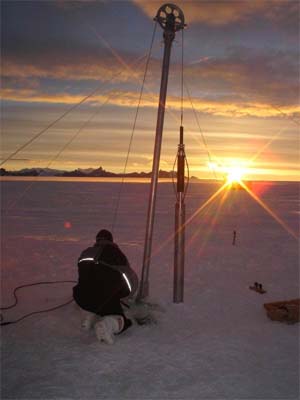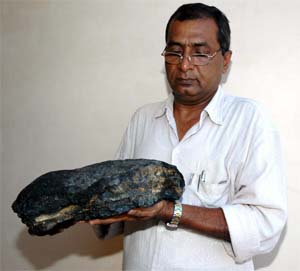Dec 24, 2025
Dec 24, 2025
by K. Jayaraman
Having done research in Antarctica for over quarter of a century, Indian scientists have started exploring another very cold place on Earth. On Aug 6, NCAOR director Rasik Ravindra and his team of four scientists landed in the Arctic in what is said to be the first of several such expeditions. There, in collaboration with Norwegian scientists, they will look for cold-adapted microbes with possible application in industry. "Systematic harvesting of the cobalt crusts beneath our seas can potentially make India rich," says Banakar who is going to lead a massive hunt for cobalt crusted mounts in north Indian Ocean under a $7.5 million government funded project. The ice core laboratory operated by Thamban Meloth at NCAOR - where the nano-bacteria were found - is the only one of its kind in the tropical world. Upgrading the department of ocean development into a full-fledged ministry of earth sciences last year has given a new thrust to oceanography research. India has already started work on third base in Antarctica. The expedition to the Arctic has signaled India's foray into the northern hemisphere. India will soon be adding a brand new ship to its research fleet and a manned submersible for underwater research. With help from Russia, India is already building a robotic vehicle that can dive up to 6,000 meters. The first prototype was tested successfully at a depth of 205 meters in October 2006. Indian oceanographers have also been promised their first ice class research vessel that Ravindra says will enable scientists "go to Antarctic in winter and to the Arctic in summer and do year-round research in the tropics". India has decided to join the Integrated Ocean Drilling Programme (IODP) as an associate member paying $1 million as annual fee. China and Korea are the only other associate members of IODP sponsored by the United States, Japan and a 17-member European consortium. Through this programme, India intends to initiate deep drilling in the Arabian Sea, the western Andamans and in the Bay of Bengal. The membership "will enable Indian scientists to join shipboard parties and sit on scientific panels", says Manik Talwani, president of Washington-based IODP, adding that "in the long term" it will help discover energy and mineral resources. "Western centers of oceanographic research in Europe and North America had sent relatively few research expeditions to the Indian Ocean due to the distance," he says in an email interview. "Thus the path is open for India for major new explorations and discoveries in its surrounding ocean." India's interest in the ocean is as much economic as it is scientific. As one of the seven pioneer investors in undersea mining, it has been allotted a 75,000 sq km area of seabed in the central Indian Ocean - strewn with manganese nodules that contain copper, nickel and cobalt. India would like to mine these someday. "In the next five years, we plan to explore all the prominent underwater mounts in the northern Indian Ocean and stake our claim whenever the International Seabed Authority is ready to open sea mounts for commercial exploitation," says Banakar. India has also put in a claim for an additional 1.5 million sq km sea floor area beyond the EEZ, says Sivramakrishnan Rajan of NCAOR. Indian expertise in 3-D bathymetry (sea bottom survey) is in fact in great demand in neighboring countries. "We have trained Sri Lankans and now Myanmar is desperate that we survey their continental shelf." But, as noted by the leading science journal Nature, India's grandiose schemes in marine research may potentially be thwarted by the creeping manpower shortage as only four or five universities in India teach oceanography. However, Satish Ramnath Shetye, director of NIO, is confident that with more funding - India will be spending $100 million on oceanographic research this year - and challenging research programmes, the trend will reverse. A fungus that can make detergents more effective, a nano-bacteria that can hold the key to understanding formation of the earth, a 60 million-year-old chunk of rock that can make India rich - Indian scientists are plumbing the depths of oceans like never before, unearthing secrets of the earth, and the sea, in their quest for unraveling the past and bettering the future.
A fungus that can make detergents more effective, a nano-bacteria that can hold the key to understanding formation of the earth, a 60 million-year-old chunk of rock that can make India rich - Indian scientists are plumbing the depths of oceans like never before, unearthing secrets of the earth, and the sea, in their quest for unraveling the past and bettering the future.
Marine biologist Kottekkadu Krishnan, for instance, at the National Centre for Antarctic and Ocean Research (NCAOR) in India's coastal state Goa is intrigued by the extremely tiny bacteria (nano-bacteria) he found in an ice core sample he brought from Antarctica. He thinks - but not everyone agrees - that the strange organisms were originally residents of the earth's mantle that were ejected during volcanic eruptions and transported to Antarctica by the ash and got trapped in ice.
Known for its beaches, Goa also hosts the National Institute of Oceanography (NIO), founded in 1966, that has grown into a major institution in ocean sciences.
At NIO, Chandralata Raghukumar is thrilled by her discovery of a fungus that she recovered from the bottom of central Indian Ocean. The fungus Aspergillus ustusproduces an enzyme that works efficiently at low temperatures. "German and US detergent manufacturers are testing our patented enzyme (US patent 2005101002) as possible additive to their products for washing clothes in cold instead of hot water," she says.
 But it is the trophy that NIO's Virupaxa Banakar scooped from an undersea mount that has excited the authorities. It is a chunk of rock covered with a seven cm thick crust that Banakar says must have taken over 60 million years to form. Analysis showed these crusts contain cobalt and platinum - both precious.
But it is the trophy that NIO's Virupaxa Banakar scooped from an undersea mount that has excited the authorities. It is a chunk of rock covered with a seven cm thick crust that Banakar says must have taken over 60 million years to form. Analysis showed these crusts contain cobalt and platinum - both precious.
Hitherto largely confined to the shores, India's oceanographers are venturing beyond and discovering things even as the country is rapidly developing new capabilities in marine science.
The thrust is taking place at many fronts.
Henry Dick, a senior scientist at the Woods Hole Oceanographic Institution (WHOI) in Massachusetts, US, believes India is ideally located to play a major role in Indian Ocean research.
Meanwhile the ministry's attention has been drawn to Banakar's discovery of cobalt crusts because they are available in shallow water as slabs capping the seamounts whereas nodules occur on seabed at abysmal depths of four km or more.
The government says the manned submersible that it intends to procure will help in the exploration of cobalt crusts and also hydrothermal sulphides and gas hydrates - a source of methane, which can be used as a fuel.
Globally, ocean mining is still accorded low priority. But India is not taking chances given the fact that its 7,500 km long coastline gives the country an exclusive economic zone (EEZ) measuring 2.2 million square km, or about two-third of its land area.
01-Sep-2007
More by : K. Jayaraman